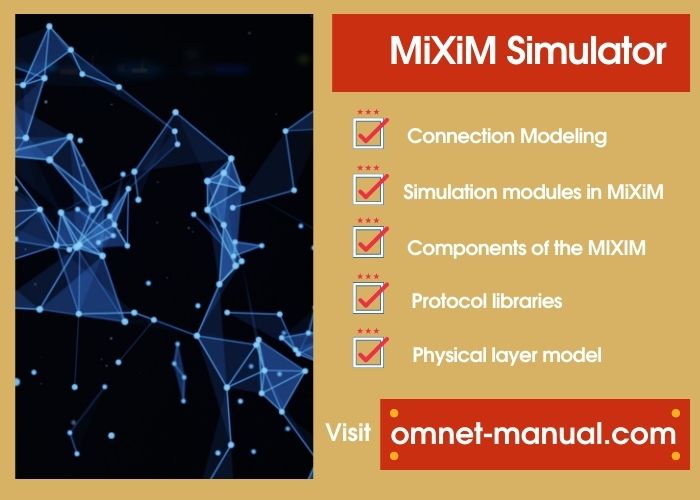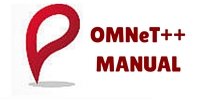Introduction about MiXiM Simulator: In current days, network simulation performance evaluation is a challenging task and all types of networks performance are improved using QoS and SLA metrics. It is a time to gain knowledge about the specific simulator called as MiXiM. Let we start,
“This article provides you a piece of knowledge about MiXiM Simulator and the base model of simulator and simulation models, its components and so on”
MiXiM is abbreviated from mixed simulator. By using OMNeT++ simulation engine to construct a framework for mobile networks and the wireless and main reason for writing this program is to increase the wireless and mobile simulation. This kind of MiXiM simulator can be interconnected with several OMNeT++ frameworks.
Base models for MiXiM Simulator
Simulation of wireless communication systems must have the physical layer, radio channels, and perfect abstraction from the environment. Here we consider three base models for MiXiM. There are,
- Connection modeling
- Physical layer models
- Environmental models
- Wireless channel models
Connection Modeling
This is one of the base models used in MiXiM Simulator. This connection modeling is directly opposite to the wired network simulation and connecting more models it’s a highly challenging process in wireless network simulations.
- If we consider wired simulation it is easy to connect two nodes by using a wire. For example OMNeT++ connection.
- But, when we consider the wireless network simulation the connection of two nodes is possible by a broadcast medium that is air. Wireless simulation is cannot easy to find out a single connection.
- Here, we classify the control modeling in two parts,
- In this first part, we consider the attenuation property of the wireless channels.
- Then, the second part denotes the connection between each and every node.
The above content represents the MiXiM base model. Then we will go to the next model in this simulator that is the physical layer model, in this model we can get a clear idea about FEC and coding gain.

Physical layer models
In this physical layer, we are using some functions for defining the throughput of a system and the bit rate of a system. Here, the functions are coding, decoding, and FEC (Forward Error Correction).
- The detecting signal of the SNR factor is denoted as a coding gain for the receiver. This coding gain concept is introduced by forwarding Error Correction and it derives from the wireless network channels.
- Due to these wireless network channels, the effects of functions model at the level of SNR.
This kind of SNR-based model can be extended when the system is finding a bit in a single channel. This extended process can be done until the bit rate is calculated where is the place in which more channels are connected.
Environmental model
A Simulation takes place in a limited area and it is based on which objects are placed and which nodes are placed. Here wireless devices are considered as nodes and it already has a protocol stack with an isotropic radiator. It does not contain any other physical dimension. MiXiM Simulator has four strategies to avoid a border crossing and collision. There are,
- Initially, the collision may occur it giving an error message.
- Then, if we select the new position in a random manner within the collision the current entity places upon backward and when another entity takes place it does not coincide with the position of another entity.
- Next, if the entity collides then it gives some reflection in angle.
- Lastly, this strategy is used for border entities in the playground. If any cause is attacked like wrapping and tours, the entity change that place in the opposite side of the playground
Wireless channel models
The frequency and space of multi parallel radio channels are always possible by MiXiM channels. Here is an example for the space is a multi-antenna system and an example of the frequency is OFDM subcarrier terms.
- MiXiM Simulator has channel models that are Small-large scale fading, path loss, shadowing these are some channel models is used in the SNR abstraction level.
- Digital signal level model operation is also enabled in the MiXiM modular structure.
The above four models are the base models for the MiXiM. Without this model the Simulation of MiXiM is difficult. So, this model is mandatory for constructing a MiXiM. Then we will go to the next topic which is Simulation modules in MiXiM. This is said to be a word utility module.
Simulation modules in MiXiM
MiXim simulator is used to collect global parameters for example whether the world is in a cube or a plane and simulated area size is a playground. Mainly, the MiXiM takes the object for an environment.
- For managing the object, and giving rest for the simulation process is the main purpose of Object-Manager and calculation of object interface within the line between the two nodes,
- In between two interfering nodes manage the connection is in a dynamic manner it’s responsible for the Connection-Manager module. This connection-manager object is well known for the position of the query object and all nodes in the network.
- Multi-connection manager is always taking responsible for radio wave and ultrasound or which signal has several frequency ranges.
- Two objects are considered that is house and wall that are also denoted respectively ObjectHouse and Object Wall. These objects have full power on the propagation of signals and nodes mobility or object mobility.
Networks are built with more nodes. Different kinds of nodes are considered in MiXiM that nodes are also called terminal and Accesspoint of the network. These are the simulation modules in the MiXiM. We learn more basics from these modules and the characteristics of the objects also. Then we will discuss Component groups in the network.
What are the components of the MiXiM Simulator?
Because of, well-developed infrastructure MiXiM gives detailed protocols and models. In this MiXiM Simulator, the basic components can be classified into five parts. There are,
- Protocol Library: This library has a rich protocol for researchers and is useful to distinguish ideas of the researchers from existing concepts
- Environment Models: In this model, we consider only real entities of the world, and those kinds of entities are called obstacles and useful for communication through the medium of air.
- Mobility and connectivity: Suddenly nodes move then the network is varied finally the simulator gives a graphical representation of the nodes based on the changes in the nodes.
- Experiment support: Here, researchers can select their templates themselves and this is an important model for them it supports distinguishing the result from other ideal state results.
- Collision and reception: In this model, the wireless network simulator has the advantage of the movement of the objects based on the received message. Transmit the signal change is fully responsible for reception handling.
These are the group of components in the MiXiM simulator. In this above content, we know some techniques like collision, reception and error handling and etc. Finally, we will see about the protocol library for the MiXiM.
Protocol libraries in MiXiM Simulator
In MiXiM simulation it is possible to change one model into another model. To add the functions and override the functions is used to a basic level of construction. Here, three types of protocol libraries are there. Then we will discuss each and every protocol separately.
- Network layer protocol
- Localization
- MAC protocols
Network Layer protocols: This protocol is used for multiple traffic constraints, for example, local neighborhood, Source to sink, and any to any, and it gives full support for simulation modules like data localization.
Localization
- The optional localization layer provides current node position information that is known as localization.
- For the use of handle Message, MiXiM has more scalable when it’s compared to Positif.
- In this word, optional gives a meaning about not in standard software protocol stack but explicitly add to the module of nodes.
MAC Protocol
This Medium Access Control protocol is mainly designed for a decision-making purpose about communication between nodes in the network and also a low power sensor network. This protocol construct by TU Delft. In Mac protocol, there are two base classes for building a sensor network. There are,
- Class name: EyesMACLayer
Uses: Provide support for low power functions and sensor networks.
- Class name : BaseMACLayer
Uses: provide a decapsulation and encapsulation of packets.
There are some protocols used in the MiXiM simulator. So far, we are discussing the basics of the MiXiM, base models, simulation modules of this simulator, and protocols also. We hope this article is useful for you and we have more number of developing and developed a project based on these kinds of topic. Our expert has a wonderful knowledge with these kinds of projects also.
